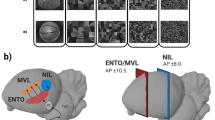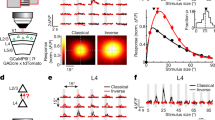Abstract
In animals with complex visual systems spatial contrast is enhanced by mutual inhibition between retinal neurones monitoring different fields1. By analogy, if animals like leeches and some caterpillars, that have several simple (non-image-forming) eyes aimed in different directions, are capable of rudimentary form detection, one might predict mutual antagonism between eyes monitoring different fields. In support of this prediction, I report here a paired interneurone in the central nervous system (CNS) of the leech which is stimulated by eyes on one side of the animal and inhibited by eyes on the other. There are striking parallels between these neurones and other integrating neurones, in particular those processing bilateral auditory input in crickets2, suggesting that the visual system of the leech may be representative of a general class of sensory processing systems.
This is a preview of subscription content, access via your institution
Access options
Subscribe to this journal
Receive 51 print issues and online access
$199.00 per year
only $3.90 per issue
Buy this article
- Purchase on Springer Link
- Instant access to full article PDF
Prices may be subject to local taxes which are calculated during checkout
Similar content being viewed by others
References
Ratliff, F. & Hartline, H. K. Studies on Excitation and Inhibition in the Retina (Chapman & Hall, London, 1974).
Wohlers, D. W. & Huber, F. J. comp. Physiol. 127, 11–28 (1978).
Muller, K. J., Nicholls, J. G. & Stent, G. S. The Neurobiology of the Leech (Cold Spring Harbor Laboratory, New York, 1981).
Kretz, J. R., Stent, G. S. & Kristan, W. B. Jr J. comp. Physiol. 106, 1–37 (1976).
Rohlich, P. & Torok, L. J. Z. Zellforsch. Mikrosk. Anat. 63, 618–635 (1964).
Lasansky, A. & Fuortes, M. G. F. J. Cell Biol. 42, 241–252 (1969).
Walther, J. B. in Functional Organization of the Compound Eye (ed. Bernard, C. G.) 329–336 (Pergamon, Oxford, 1966).
Fioravanti, R. & Fuortes, M. G. F. J. Physiol., Lond. 227, 173–194 (1972).
Nicholls, J. G. & Purves, D. J. Physiol., Lond. 209, 647–667 (1970).
Stewart, W. Cell 14, 741–747 (1978).
Tabata, M. & Alkon, D. L. J. Neurophysiol. 48, 174–191 (1982).
Dethier, V. G. J. cell. comp. Physiol. 19, 310–313 (1942).
Dethier, V. G. J. cell. comp. Physiol. 22, 115–126 (1943).
Hundertmark, A. Z. vergl. Physiol. 24, 563–582 (1937).
Wilson, M. J. comp. Physiol. 124, 297–316 (1978).
Taylor, C. P. J. exp. Biol. 93, 1–18 (1981).
Muller, K. J. & McMahan, U. J. Proc. R. Soc. B194, 481–499 (1976).
Author information
Authors and Affiliations
Rights and permissions
About this article
Cite this article
Peterson, E. Visual processing in the leech central nervous system. Nature 303, 240–242 (1983). https://doi.org/10.1038/303240a0
Received:
Accepted:
Issue Date:
DOI: https://doi.org/10.1038/303240a0
This article is cited by
-
Parallel pathways coordinate crawling in the medicinal leech, Hirudo medicinalis
Journal of Comparative Physiology A (1995)
-
Visual interneurons in the leech brain
Journal of Comparative Physiology A (1985)
-
Visual interneurons in the leech brain
Journal of Comparative Physiology A (1985)
-
Visual interneurons in the leech brain
Journal of Comparative Physiology A (1985)
-
The fast conducting system of the leech: a network of 93 dye-coupled interneurons
Journal of Comparative Physiology A (1984)
Comments
By submitting a comment you agree to abide by our Terms and Community Guidelines. If you find something abusive or that does not comply with our terms or guidelines please flag it as inappropriate.



